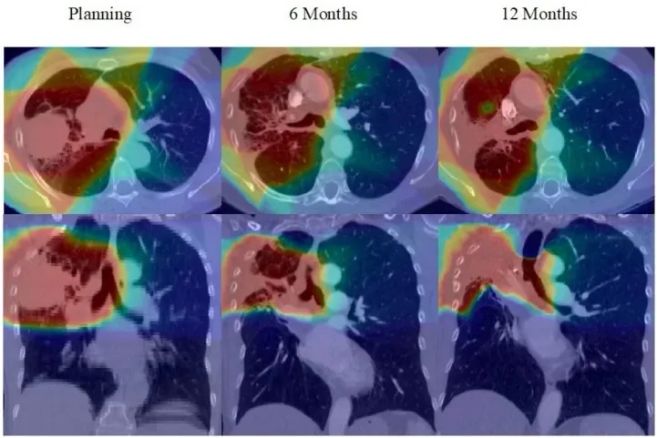Long-Term Side Effects of Lung Cancer Radiotherapy: What You Need to Know
Radiotherapy is a powerful tool in treating lung cancer, but it can come with long-term side effects. This article explains what to expect, how to manage and reduce risks, and how advanced techniques like proton therapy, CyberKnife, and motion management can help protect your quality of life during and after treatment.


Jump to:
- What are Long-Term Side Effects?
- Management of Long-Term Effects
- Pulmonary Rehabilitation
- Cardiac Care
- Nutritional Support or oesophageal intervention
- Prevention of long-term side effects is better than cure!
- Advanced motion management techniques
- Proton Therapy (PBT) for lung cancer
- Coping with Long-Term Side Effects
- Conclusion
Radiotherapy is a potentially curative treatment for lung cancer. However, like all medical treatments, it comes with potential side effects, some of which may persist long after the therapy has concluded. As the effectiveness of radiotherapy for lung cancer increases, and drug treatments improve the likelihood of long-term survival for patients with lung cancer, the need to minimise side effects side effects that occur after treatment become even more important. This post explores the long-term side effects of radiotherapy for lung cancer, offering insights into management strategies and the latest advancements in treatment techniques that I offer to minimise these effects and maintain your quality of life.
What are Long-Term Side Effects?
Long-term side effects of radiotherapy are those that either continue for months after treatment or develop years later. They can vary widely among patients depending on the specific area treated, the radiation dose, and the individual’s overall health. Common long-term side effects for lung cancer patients may include:
– Lung Changes: Fibrosis (scarring of the lung tissue) is a common issue and can lead to a persistent cough or shortness of breath.
– Cardiac Effects: In some cases, radiation can affect heart health, especially if the heart was within the radiation field. This is particularly true for people who have pre-existing heart problems or risk factors.
– Oesophageal Changes: Difficulty swallowing, known as dysphagia, can occur if the oesophagus was exposed to radiation.
– Secondary Cancers: A very small increased risk of developing a second cancer in the areas treated with radiation exists. As this risk is many years after treatment, it is only now that that chance of cure is improving that this is increasing in importance. The risk is very low (3 in 1000 at 10 years, 5 in 1000 at 15 years after treatment).
It’s important to remember that not everyone experiences side effects. The benefits of eradicating cancer far outweigh the potential risks.
Management of Long-Term Effects
Managing long-term side effects involves regular monitoring and early intervention. Here are some ways to handle these persistent effects:
Pulmonary Rehabilitation
Pulmonary rehabilitation programs can help improve lung function after radiotherapy. These programs typically include exercise training, education, and support, aimed at enhancing quality of life.
Cardiac Care
For patients with potential heart issues post-radiotherapy, regular cardiovascular check-ups and monitoring might be recommended. This may include echocardiograms, ECGs and stress tests to monitor heart health and function.
Nutritional Support or oesophageal intervention
Patients experiencing oesophageal changes may benefit from dietary adjustments. If needed, a dietitian can recommend meals that are more comfortable to swallow, ensuring that nutrition does not suffer. Very rarely, we may need to perform an endoscopy to relieve any narrowing of the oesophagus to restore a normal swallow.
Prevention of long-term side effects is better than cure!
Advancements in radiotherapy techniques have dramatically improved the precision with which radiation is delivered, significantly reducing the risk of long-term side effects. At all my clinics, I utilise the latest technology and treatment protocols to ensure the highest standards of care:
Intensity-Modulated Radiotherapy (IMRT) or Volumetric Modulated Arc Therapy (VMAT)
IMRT and VMAT allow for the radiation dose to be shaped precisely around the tumour, minimising exposure to healthy tissues and reducing the risk of side effects.
Image-Guided Radiotherapy (IGRT)
IGRT helps to significantly reduce the risk of long-term side effects associated with traditional radiotherapy methods. IGRT involves frequent imaging during treatment, ensuring that radiation is accurately targeted, which is crucial for tumours that move, like those in the lung. This greatly enhances the precision and effectiveness of radiotherapy, but also ensures important, critical structures are spared from high doses of radiation.
Advanced motion management techniques
These techniques are designed to precisely target tumours while protecting healthy tissues, even as patients breathe and their internal organs naturally move. I personalise the use of these techniques to each individual patient with the aim of reducing the amount of normal tissue that receives any radiation dose and therefore reduce side effects.
– Breath-Hold Techniques
Breath-hold technologies, such as Active Breathing Control (ABC), allow doctors to deliver radiation while the lungs are in a consistent position. By instructing the patient to hold their breath at a specific point in their breathing cycle, the movement of the lung and heart is minimised. This stability enables more accurate targeting of the tumour, significantly reducing radiation exposure to healthy tissues and thus lowering the risk of heart and lung damage.
– CyberKnife Tumour Tracking
The CyberKnife system represents a revolutionary approach in radiotherapy. It features real-time tumour tracking technology, which tracks the tumour’s position during each breath and adjusts the radiation beam accordingly. This dynamic synchronisation means that even tumours that move with each breath can be targeted with extreme precision, sparing surrounding healthy tissues from unnecessary radiation and reducing side effects.
– Abdominal Compression
Abdominal compression is another effective technique used to reduce the movement of tumours in the chest and abdomen during radiation treatment. By gently compressing the abdomen, this method restricts the range of tumour motion due to breathing, which enhances the accuracy of radiation delivery. This not only improves the effectiveness of the treatment but also minimises the exposure of healthy organs to radiation.
These advanced motion management techniques represent a significant step forward in the treatment of lung cancer. By improving the precision of radiation delivery, they reduce the risk of damaging critical organs and tissues, thereby offering patients a better quality of life both during and after treatment.
Proton Therapy (PBT) for lung cancer
Proton beam therapy is a cutting-edge form of radiotherapy that is gaining traction in the treatment of lung cancer due to its precision and potential to reduce long-term side effects. Unlike traditional radiotherapy that uses X-rays, proton therapy uses protons — positively charged particles — which have a unique advantage. They can be programmed to deliver their energy directly to the tumour site with remarkable precision, minimising exposure to surrounding healthy tissues.
Proton beam therapy offers a type of radiation that stops at the tumour, significantly reducing the dose delivered to the surrounding normal tissues and thereby lowering the risk of long-term damages. In selected patients, those most at risk of long-term or serious side effects, I can treat patients with proton beam therapy at Proton International London (https://www.protonintlondon.com/consultants/dr-james-wilson/)
The ability of proton beam therapy to precisely target tumours means that higher doses of radiation can be used to kill cancer cells while sparing healthy tissues and organs. This can lower the incidence of side effects that patients might experience both during and after treatment.
Another potential benefit of proton therapy is its potential to reduce the likelihood of secondary cancers. Secondary cancers are a serious concern for long-term survivors of lung cancer, often triggered by exposure of healthy tissues to radiation. By limiting this exposure, proton therapy helps to minimise the risk of developing new cancers later on.
For patients undergoing lung cancer treatment, proton beam therapy offers a hopeful path with fewer long-term health concerns. This technique embodies the advancements in medical technology aimed at not just treating cancer more effectively, but also enhancing the quality of life for survivors by minimising adverse effects.
Coping with Long-Term Side Effects
Coping with long-term side effects can be challenging, but with the right strategies and support, many patients manage their symptoms effectively. All the patients that I treat are given access to all the necessary support to both prevent side effects from developing, but also minimise their impact should they occur. All patients will have access to support groups, counselling/talking therapies, and rehabilitation programs if so desired or needed. Dieticians, physiotherapists and occupational therapists will be consulted during treatment. These can be invaluable resources for patients and their families.
Conclusion
While the prospect of long-term side effects from radiotherapy can be daunting, it’s important to balance these concerns with the benefits of treating lung cancer effectively. With ongoing advancements in radiotherapy technology and techniques, the risk of severe side effects continues to decrease. We are committed to providing the safest and most effective treatment options, ensuring that you receive the best possible care tailored to your individual needs.
Regular follow-ups, a focus on symptom management, and the use of cutting-edge technology help us minimise side effects and support you through your recovery journey and help you return to your normal life after treatment. If you have any concerns about radiotherapy or its potential long-term effects, please don’t hesitate to reach out. We are here to help every step of the way.
Remember, every patient’s journey is unique, and we are dedicated to ensuring yours is as smooth and comfortable as possible. We will offer you the right treatment, at the right time in a way that is personalised to your individual needs.
Contact us on +44 (0)20 7993 6716 to discuss how I can help you receive the best treatment for lung cancer – to eradicate the tumour, while minimising long-term side effects.